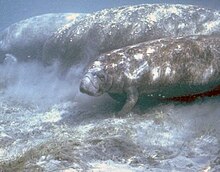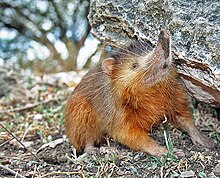List of mammals of Haiti
This is a list of the mammal species recorded in Haiti. Of the mammal species in Haiti, one is critically endangered, one is endangered, two are vulnerable, and eleven are considered to be extinct.[1]
The following tags are used to highlight each species' conservation status as assessed by the International Union for Conservation of Nature:
| EX | Extinct | No reasonable doubt that the last individual has died. |
| EW | Extinct in the wild | Known only to survive in captivity or as a naturalized populations well outside its previous range. |
| CR | Critically endangered | The species is in imminent risk of extinction in the wild. |
| EN | Endangered | The species is facing an extremely high risk of extinction in the wild. |
| VU | Vulnerable | The species is facing a high risk of extinction in the wild. |
| NT | Near threatened | The species does not meet any of the criteria that would categorise it as risking extinction but it is likely to do so in the future. |
| LC | Least concern | There are no current identifiable risks to the species. |
| DD | Data deficient | There is inadequate information to make an assessment of the risks to this species. |
Order: Sirenia (manatees and dugongs)[]
Sirenia is an order of fully aquatic, herbivorous mammals that inhabit rivers, estuaries, coastal marine waters, swamps, and marine wetlands. All four species are endangered.
- Family: Trichechidae
- Genus: Trichechus
- West Indian manatee, T. manatus VU presence uncertain
- Genus: Trichechus
Order: Rodentia (rodents)[]
Rodents make up the largest order of mammals, with over 40% of mammalian species. They have two incisors in the upper and lower jaw which grow continually and must be kept short by gnawing. Most rodents are small though the capybara can weigh up to 45 kg (99 lb).
- Suborder: Hystricognathi
- Family: Capromyidae
- Tribe: Plagiodontini
- Genus: Hyperplagiodontia
- Wide-toothed hutia, H. araeum EX
- Genus: Plagiodontia
- Hispaniolan hutia, Plagiodontia aedium EN
- Samaná hutia, Plagiodontia ipnaeum EX
- , Plagiodontia spelaeum[2] EX
- Genus: Rhizoplagiodontia
- Lemke's hutia, Rhizoplagiodontia lemkei EX
- Genus: Hyperplagiodontia
- Subfamily: Isolobodontinae
- Genus: Isolobodon
- Montane hutia, Isolobodon montanus EX
- Puerto Rican hutia, Isolobodon portoricensis EX
- Genus: Isolobodon
- Subfamily: Hexolobodontinae
- Genus: Hexolobodon
- Imposter hutia, Hexolobodon phenax EX
- Genus: Hexolobodon
- Tribe: Plagiodontini
- Family: Heptaxodontidae
- Subfamily:
- Genus: Quemisia
- Twisted-toothed mouse, Quemisia gravis EX
- Genus: Quemisia
- Subfamily:
- Family: Capromyidae
Order: Eulipotyphla (shrews, hedgehogs, moles, and solenodons)[]
Eulipotyphlans are insectivorous mammals. Shrews and solenodons closely resemble mice, hedgehogs carry spines, while moles are stout-bodied burrowers.
- Family: Nesophontidae
- Genus: Nesophontes
- Atalaye nesophontes, Nesophontes hypomicrus EX
- Western Cuban nesophontes, Nesophontes micrus EX
- St. Michel nesophontes, Nesophontes paramicrus EX
- Haitian nesophontes, Nesophontes zamicrus EX
- Genus: Nesophontes
- Family: Solenodontidae
- Genus: Solenodon
- Marcano's solenodon, S. marcanoi EX
- Hispaniolan solenodon, S. paradoxus LC
- Genus: Solenodon
Order: Chiroptera (bats)[]
The bats' most distinguishing feature is that their forelimbs are developed as wings, making them the only mammals capable of flight. Bat species account for about 20% of all mammals.
- Family: Noctilionidae
- Genus: Noctilio
- Greater bulldog bat, Noctilio leporinus LC
- Genus: Noctilio
- Family: Vespertilionidae
- Subfamily: Vespertilioninae
- Genus: Lasiurus
- Minor red bat, Lasiurus minor VU
- Genus: Lasiurus
- Subfamily: Vespertilioninae
- Family: Molossidae
- Genus: Molossus
- Velvety free-tailed bat, Molossus molossus LC
- Genus: Nyctinomops
- Big free-tailed bat, Nyctinomops macrotis LC
- Genus: Tadarida
- Mexican free-tailed bat, Tadarida brasiliensis LC
- Genus: Molossus
- Family: Mormoopidae
- Genus: Mormoops
- Antillean ghost-faced bat, Mormoops blainvillii LC
- Genus: Pteronotus
- Parnell's mustached bat, Pteronotus parnellii LC
- Sooty mustached bat, Pteronotus quadridens LC
- Genus: Mormoops
- Family: Phyllostomidae
- Subfamily: Phyllostominae
- Genus: Macrotus
- Waterhouse's leaf-nosed bat, Macrotus waterhousii LC
- Genus: Macrotus
- Subfamily: Brachyphyllinae
- Genus: Brachyphylla
- Cuban fruit-eating bat, Brachyphylla nana LC
- Genus: Brachyphylla
- Subfamily:
- Genus: Phyllonycteris
- Cuban flower bat, Phyllonycteris poeyi LC
- Genus: Phyllonycteris
- Subfamily: Glossophaginae
- Genus: Monophyllus
- Leach's single leaf bat, Monophyllus redmani LC
- Genus: Monophyllus
- Subfamily: Stenodermatinae
- Genus: Artibeus
- Jamaican fruit bat, Artibeus jamaicensis LC
- Genus: Phyllops
- Cuban fig-eating bat, Phyllops falcatus LC
- Genus: Artibeus
- Subfamily: Phyllostominae
- Family: Natalidae
- Genus: Chilonatalus
- Cuban funnel-eared bat, Chilonatalus micropus VU
- Genus: Chilonatalus
Order: Cetacea (whales)[]
The order Cetacea includes whales, dolphins and porpoises. They are the mammals most fully adapted to aquatic life with a spindle-shaped nearly hairless body, protected by a thick layer of blubber, and forelimbs and tail modified to provide propulsion underwater.
- Suborder: Mysticeti
- Family: Balaenopteridae (baleen whales)
- Genus: Balaenoptera
- Common minke whale, Balaenoptera acutorostrata LC
- Sei whale, Balaenoptera borealis EN
- Bryde's whale, Balaenoptera brydei DD
- Blue whale, Balaenoptera musculus EN
- Genus: Megaptera
- Humpback whale, Megaptera novaeangliae LC
- Genus: Balaenoptera
- Family: Balaenopteridae (baleen whales)
- Suborder: Odontoceti
- Superfamily: Platanistoidea
- Family: Delphinidae (marine dolphins)
- Genus: Delphinus
- Short-beaked common dolphin, Delphinus delphis LC
- Genus: Feresa
- Pygmy killer whale, Feresa attenuata DD
- Genus: Globicephala
- Short-finned pilot whale, Globicephala macrorhyncus DD
- Genus: Lagenodelphis
- Fraser's dolphin, Lagenodelphis hosei LC
- Genus: Grampus
- Risso's dolphin, Grampus griseus LC
- Genus: Orcinus
- Killer whale, Orcinus orca DD
- Genus: Peponocephala
- Melon-headed whale, Peponocephala electra LC
- Genus: Pseudorca
- False killer whale, Pseudorca crassidens DD
- Genus: Stenella
- Pantropical spotted dolphin, Stenella attenuata LC
- Clymene dolphin, Stenella clymene DD
- Striped dolphin, Stenella coeruleoalba LC
- Atlantic spotted dolphin, Stenella frontalis DD
- Spinner dolphin, Stenella longirostris DD
- Genus: Steno
- Rough-toothed dolphin, Steno bredanensis LC
- Genus: Tursiops
- Common bottlenose dolphin, Tursiops truncatus LC
- Genus: Delphinus
- Family: Physeteridae (sperm whales)
- Genus: Physeter
- Sperm whale, Physeter macrocaphalus VU
- Genus: Physeter
- Family: Kogiidae (dwarf sperm whales)
- Genus: Kogia
- Pygmy sperm whale, Kogia breviceps DD
- Dwarf sperm whale, Kogia sima DD
- Genus: Kogia
- Family: Delphinidae (marine dolphins)
- Superfamily Ziphioidea
- Family: Ziphidae (beaked whales)
- Genus: Mesoplodon
- Gervais' beaked whale, Mesoplodon europaeus DD
- Blainville's beaked whale, Mesplodon densirostris DD
- Genus: Ziphius
- Cuvier's beaked whale, Ziphius cavirostris LC
- Genus: Mesoplodon
- Family: Ziphidae (beaked whales)
- Superfamily: Platanistoidea
Order: Carnivora (carnivorans)[]
There are over 260 species of carnivorans, the majority of which feed primarily on meat. They have a characteristic skull shape and dentition.
- Suborder: Pinnipedia
- Family: Phocidae (earless seals)
- Genus: Neomonachus
- Caribbean monk seal, N. tropicalis EX
- Genus: Neomonachus
- Family: Phocidae (earless seals)
Notes[]
- ^ This list is derived from the IUCN Red List which lists species of mammals and includes those mammals that have recently been classified as extinct (since 1500 AD). The taxonomy and naming of the individual species is based on those used in existing Wikipedia articles as of 21 May 2007 and supplemented by the common names and taxonomy from the IUCN, Smithsonian Institution, or University of Michigan where no Wikipedia article was available.
- ^ Fabre, P.-H., Upham, N. S., Emmons, L. H., Justy, F., Leite, Y. L. R., Loss, A. C., Orlando, L., Tilak, M.-K., Patterson, B. D., and Douzery, E. J. P. (2017). Mitogenomic Phylogeny, Diversification, and Biogeography of South American Spiny Rats. Molecular Biology and Evolution. 34 (3): 613–633. Retrieved from https://www.mammaldiversity.org/explore.html#species-id=1001393.
References[]
- "The IUCN Red List of Threatened Species: Mammals of Haiti". IUCN. 2001. Retrieved 22 May 2007.[dead link]
- "Mammal Species of the World". Smithsonian National Museum of Natural History. 2005. Archived from the original on 27 April 2007. Retrieved 22 May 2007.
- "Animal Diversity Web". University of Michigan Museum of Zoology. 1995–2006. Retrieved 22 May 2007.
See also[]
- Lists of mammals by location
- Lists of biota of Haiti
- Mammals of Haiti




